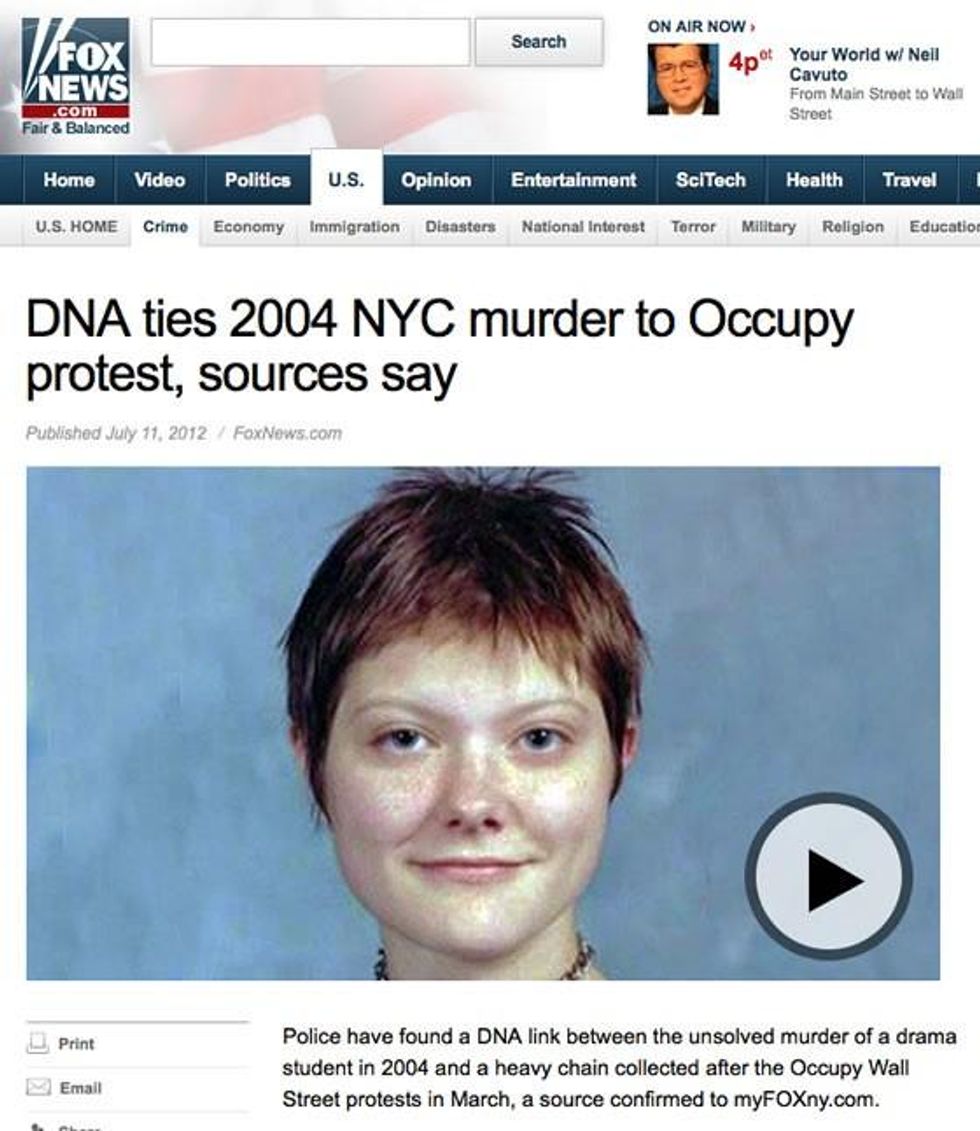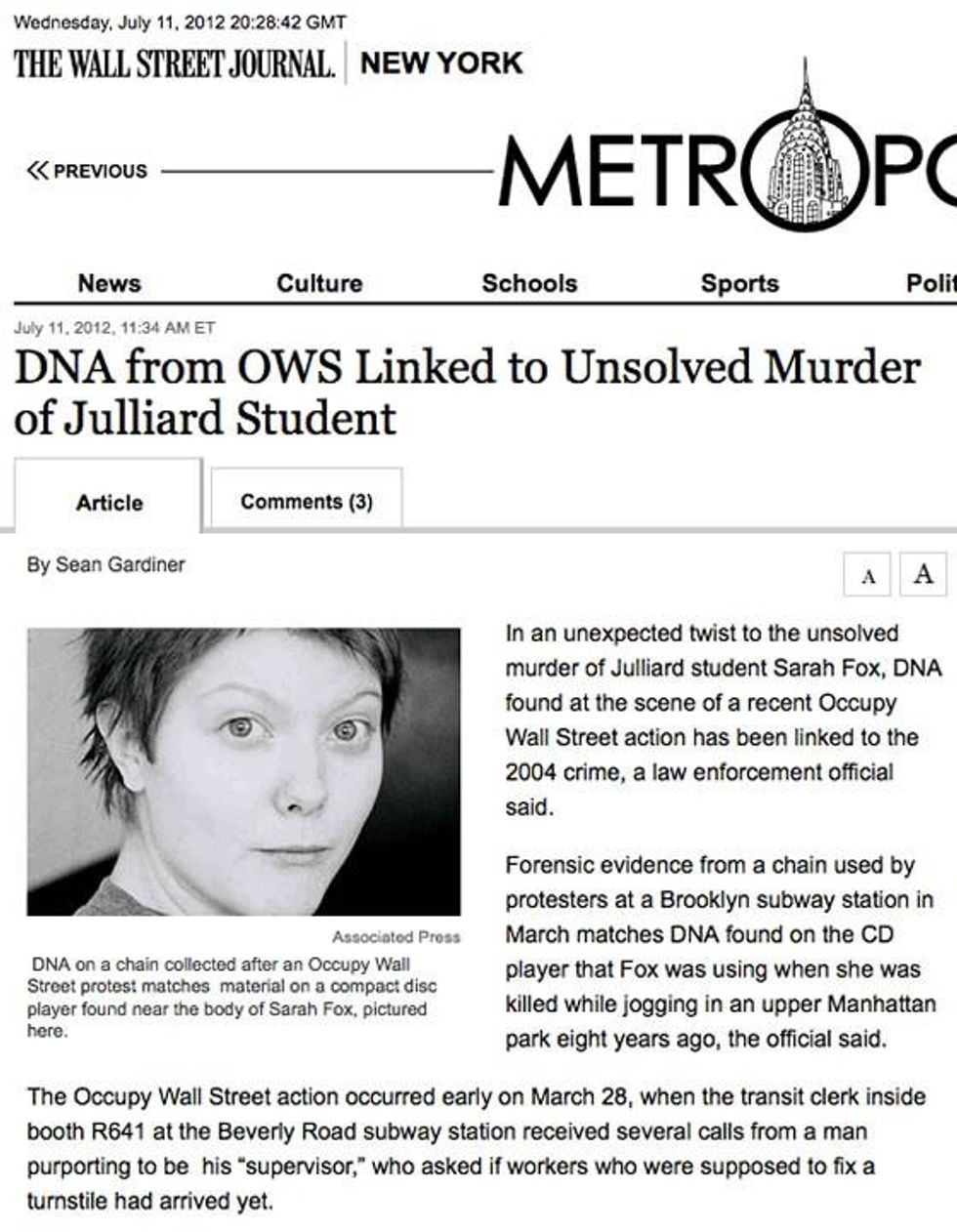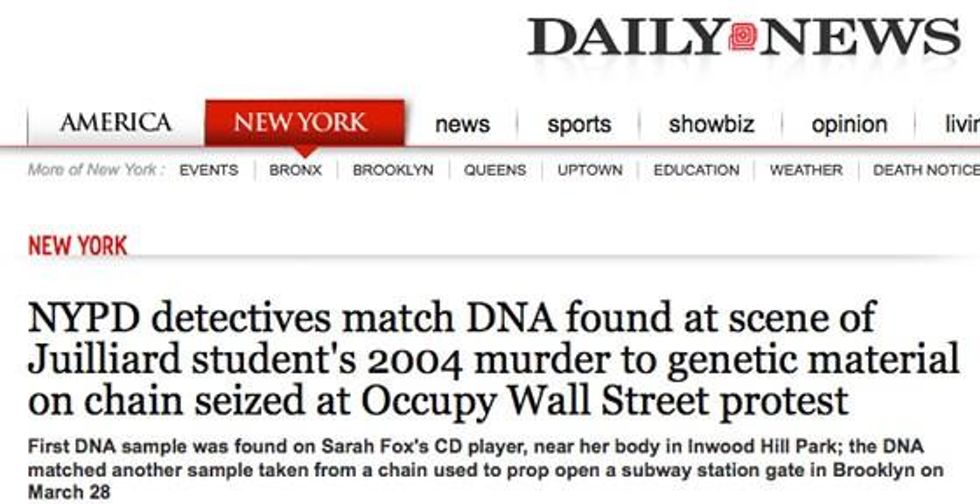

SUBSCRIBE TO OUR FREE NEWSLETTER
Daily news & progressive opinion—funded by the people, not the corporations—delivered straight to your inbox.
5
#000000
#FFFFFF
To donate by check, phone, or other method, see our More Ways to Give page.


Daily news & progressive opinion—funded by the people, not the corporations—delivered straight to your inbox.
Corporate media outlets spent Wednesday headlining shocking news: the New York Police Department had found DNA that linked the Occupy Wall Street protests to an unsolved 2004 murder.
NBC New York reported, "forensic evidence from the 2004 murder scene of a Juilliard student" named Sarah Fox has been linked to "the scene of recent Occupy Wall Street subway vandalism." DNA on a CD player found at the crime scene matches "DNA found on a chain left by Occupy Wall Street protesters at the Beverly Road subway station in East Flatbush on March 28, 2012."
But now, the corporate media's anti-Occupy movement narrative seems to have hit a major snag.
The New York Times is reporting late Wednesday afternoon:
The DNA match that suggested a possible link between the unsolved killing of a Juilliard student in 2004 and a chain recovered at the site of an Occupy Wall Street protest in March was the result of a laboratory error, a person briefed on the matter said on Wednesday.
The DNA that investigators initially believed was recovered from skin cells on the slain woman's portable compact disc player and from the chain found after the March protest came from a laboratory supervisor at the Office of the Chief Medical Examiner, the person said.
"The O.C.M.E. tainted the samples and it was the O.C.M.E. supervisor's whose DNA was on both," the person said.
But Ellen Borakove, a spokeswoman for the Medical Examiner's Office, denied that the DNA had come from laboratory personnel.
The Medical Examiner's Office maintains a database of employees' DNA for the purpose of eliminating such errors.
OWS activists, meanwhile, were furious the movement had been linked to the homicide -- and indignant that DNA was used to find out who propped open the subway gate March 28.
"Obviously it's a terrible murder, but the story here is really the NYPD rubbing for DNA on some chains at a peaceful Occupy Wall Street demonstration," said Ed Needham, a member of the press-relations team for OWS.
"That's a lot of resources to give to something when there's so many other things in this city that need such desperate resources."
* * *

* * *

* * *

# # #
Dear Common Dreams reader, The U.S. is on a fast track to authoritarianism like nothing I've ever seen. Meanwhile, corporate news outlets are utterly capitulating to Trump, twisting their coverage to avoid drawing his ire while lining up to stuff cash in his pockets. That's why I believe that Common Dreams is doing the best and most consequential reporting that we've ever done. Our small but mighty team is a progressive reporting powerhouse, covering the news every day that the corporate media never will. Our mission has always been simple: To inform. To inspire. And to ignite change for the common good. Now here's the key piece that I want all our readers to understand: None of this would be possible without your financial support. That's not just some fundraising cliche. It's the absolute and literal truth. We don't accept corporate advertising and never will. We don't have a paywall because we don't think people should be blocked from critical news based on their ability to pay. Everything we do is funded by the donations of readers like you. Will you donate now to help power the nonprofit, independent reporting of Common Dreams? Thank you for being a vital member of our community. Together, we can keep independent journalism alive when it’s needed most. - Craig Brown, Co-founder |
Corporate media outlets spent Wednesday headlining shocking news: the New York Police Department had found DNA that linked the Occupy Wall Street protests to an unsolved 2004 murder.
NBC New York reported, "forensic evidence from the 2004 murder scene of a Juilliard student" named Sarah Fox has been linked to "the scene of recent Occupy Wall Street subway vandalism." DNA on a CD player found at the crime scene matches "DNA found on a chain left by Occupy Wall Street protesters at the Beverly Road subway station in East Flatbush on March 28, 2012."
But now, the corporate media's anti-Occupy movement narrative seems to have hit a major snag.
The New York Times is reporting late Wednesday afternoon:
The DNA match that suggested a possible link between the unsolved killing of a Juilliard student in 2004 and a chain recovered at the site of an Occupy Wall Street protest in March was the result of a laboratory error, a person briefed on the matter said on Wednesday.
The DNA that investigators initially believed was recovered from skin cells on the slain woman's portable compact disc player and from the chain found after the March protest came from a laboratory supervisor at the Office of the Chief Medical Examiner, the person said.
"The O.C.M.E. tainted the samples and it was the O.C.M.E. supervisor's whose DNA was on both," the person said.
But Ellen Borakove, a spokeswoman for the Medical Examiner's Office, denied that the DNA had come from laboratory personnel.
The Medical Examiner's Office maintains a database of employees' DNA for the purpose of eliminating such errors.
OWS activists, meanwhile, were furious the movement had been linked to the homicide -- and indignant that DNA was used to find out who propped open the subway gate March 28.
"Obviously it's a terrible murder, but the story here is really the NYPD rubbing for DNA on some chains at a peaceful Occupy Wall Street demonstration," said Ed Needham, a member of the press-relations team for OWS.
"That's a lot of resources to give to something when there's so many other things in this city that need such desperate resources."
* * *

* * *

* * *

# # #
Corporate media outlets spent Wednesday headlining shocking news: the New York Police Department had found DNA that linked the Occupy Wall Street protests to an unsolved 2004 murder.
NBC New York reported, "forensic evidence from the 2004 murder scene of a Juilliard student" named Sarah Fox has been linked to "the scene of recent Occupy Wall Street subway vandalism." DNA on a CD player found at the crime scene matches "DNA found on a chain left by Occupy Wall Street protesters at the Beverly Road subway station in East Flatbush on March 28, 2012."
But now, the corporate media's anti-Occupy movement narrative seems to have hit a major snag.
The New York Times is reporting late Wednesday afternoon:
The DNA match that suggested a possible link between the unsolved killing of a Juilliard student in 2004 and a chain recovered at the site of an Occupy Wall Street protest in March was the result of a laboratory error, a person briefed on the matter said on Wednesday.
The DNA that investigators initially believed was recovered from skin cells on the slain woman's portable compact disc player and from the chain found after the March protest came from a laboratory supervisor at the Office of the Chief Medical Examiner, the person said.
"The O.C.M.E. tainted the samples and it was the O.C.M.E. supervisor's whose DNA was on both," the person said.
But Ellen Borakove, a spokeswoman for the Medical Examiner's Office, denied that the DNA had come from laboratory personnel.
The Medical Examiner's Office maintains a database of employees' DNA for the purpose of eliminating such errors.
OWS activists, meanwhile, were furious the movement had been linked to the homicide -- and indignant that DNA was used to find out who propped open the subway gate March 28.
"Obviously it's a terrible murder, but the story here is really the NYPD rubbing for DNA on some chains at a peaceful Occupy Wall Street demonstration," said Ed Needham, a member of the press-relations team for OWS.
"That's a lot of resources to give to something when there's so many other things in this city that need such desperate resources."
* * *

* * *

* * *

# # #